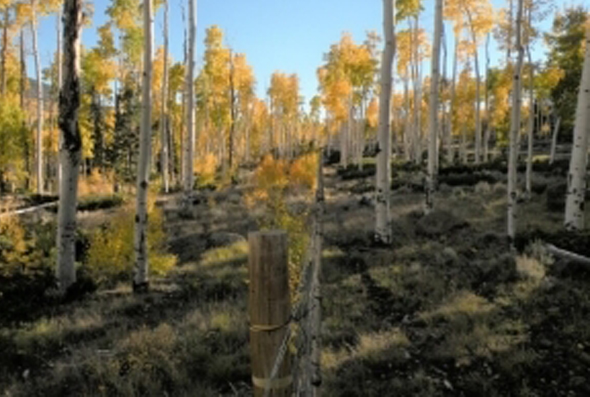

位于犹他州的白杨树林,又叫Pando的单一有机体系,由于食草动物席卷了向外扩张生长的新生小树,Pando正在逐渐退化。
撰文\播音:安妮•斯尼德(Annie Sneed)
翻译:陈美娟
审校:许楠
It lives in south-central Utah. And it’s huge. In fact, it is thought to be the largest living thing on the planet. It’s a stand of trees, a field of aspens all clones and all connected at the roots. Called Pando, the grove was first characterized by scientists in the 1970s, and it’s probably existed for many thousands of years. But now a study finds that this this massive, ancient organism is failing.
它生活在犹他州的南部中心地带。它体型庞大。实际上,它被认为是世界上最大的生命体。它是一片树林,整片的无性繁殖的白杨树通过根部连在一起。它叫Pando,20世纪70年代科学家首次发现了这片树林的特点,它可能已经存活了几千年了。但现在研究发现,这种巨大的、古老的有机体正在消亡。
“More than 80 percent of the entire Pando clone is in a nonsustainable state that has the potential to collapse and significantly reduce the size of this world’s largest organism in the next 10 to 20 years.” Paul Rogers, director of the Western Aspen Alliance at Utah State University.
“在Pando,超过80%的克隆树处于一种不可持续的状态中,这表明世界上最大的有机体在10到20年之内有明显萎缩或者崩塌掉的可能。”犹他州立大学西部山杨林联盟的主席保罗·罗杰斯(Paul Rogers)如是说。
The cause of this crisis? Herbivores, mostly deer. Parts of Pando are fenced off, but that section is still under attack. “Young aspen trees are so nutritious that animals really want to get them, particularly late in the year when the rest of the forest plants are senest and dried up..., I think that there’s perhaps some very healthy [animals that] are able to jump over the eight-foot fence.”
至于造成危机的原因?这就要怪食草动物了,尤其是鹿。Pando的部分区域已经用栅栏拦住了,但这些区域仍然收到了袭击。“幼年的白杨树富含营养,以至于动物们都想要吃掉它,尤其是在近几年,剩余的树种都变老变干了的情况下……我想可能有些比较健壮的(动物)能够越过八英尺高的栅栏。”
The deers’ aggressive browsing of young aspen poses a huge threat to Pando. “We see a big gap in the demography. And I often use the human analogy that this is a forest that is almost completely composed of senior citizens, and we have no mature, healthy individuals, we have no middle-aged, we have no teenagers, we have no babies. And that’s a really dangerous situation for aspen because it really depends on continuous growth of the whole clone. You should have a really diverse age and height structure.”
鹿群对幼年白杨树的肆虐给Pando造成了严重威胁。“我们用人口统计学分析看到了一个年龄断崖。我经常使用人类的类比来说明,这是一个几乎完全由老年人组成的森林系统,这里没有成年的、健康的个体,没有中年,没有青年,也没有婴儿。这对于白杨树林来说是个非常危险的境况,因为它完全依赖克隆体不断的生长。(在一个系统中)应该包含各种年龄段和生长阶段。”
The problem has largely been created by humans and our game management strategies. Rogers says those strategies need to be reconsidered if we want to protect Pando. And it’s not just about saving the world’s largest organism for its own sake.
人类活动和对白杨树林的管理方式也加重了这个问题罗杰斯说,如果我们想要保护Pando的话,需要重新考虑和执行这些管理策略,而不仅仅是“保护世界上最大的有机体系本身”这么简单。
“Aspen here and, in fact, worldwide harbor great amounts of biodiversity…, hundreds of plants and animals that are dependent on aspen ecosystems. In the Western U.S., the lower 48, aspen, second to riparian systems, are the most biodiverse forests that we have. Another term for that is Aspen is a keystone species. So as aspen goes so do all those dependent species. So that’s the number one reason.
“实际上,这里以及全世界的白杨树林中都蕴藏着丰富的生物多样性,有很多动植物都依赖于白杨树林生态系统。在美国西部,美国本土的48个州里,白杨树林是生物多样性第二多的树林,仅次于水滨生态系统。换句话说白杨树是生态系统的关键物种。因此白杨树林的存亡决定所有其它物种的存亡。这是我们要保护白杨树林首要的原因。”
“Specific to Pando, this closely demarcated 106 acres or 43 hectares is something that’s workable that we can see and feel and look at and people know about or are learning more about. And so…as a conservation symbol it’s like, if we can’t fix this one thing that has this international reputation, what does that say about our greater relationships with the Earth and living compatibly with the planet?”
“具体谈到Pando,在这点106英亩或43公顷的被圈起来的地方,我们可以看到、感觉到和观察到人们正在了解或学习更多的东西。白杨树林是保护区的象征,同时其存亡与否联系到环境保护的国际声誉,如果我们不能把这个问题解决的话,还谈什么与地球的更好地联系,与地球和谐地相处呢?”
 京公网安备11010502039775号
京公网安备11010502039775号